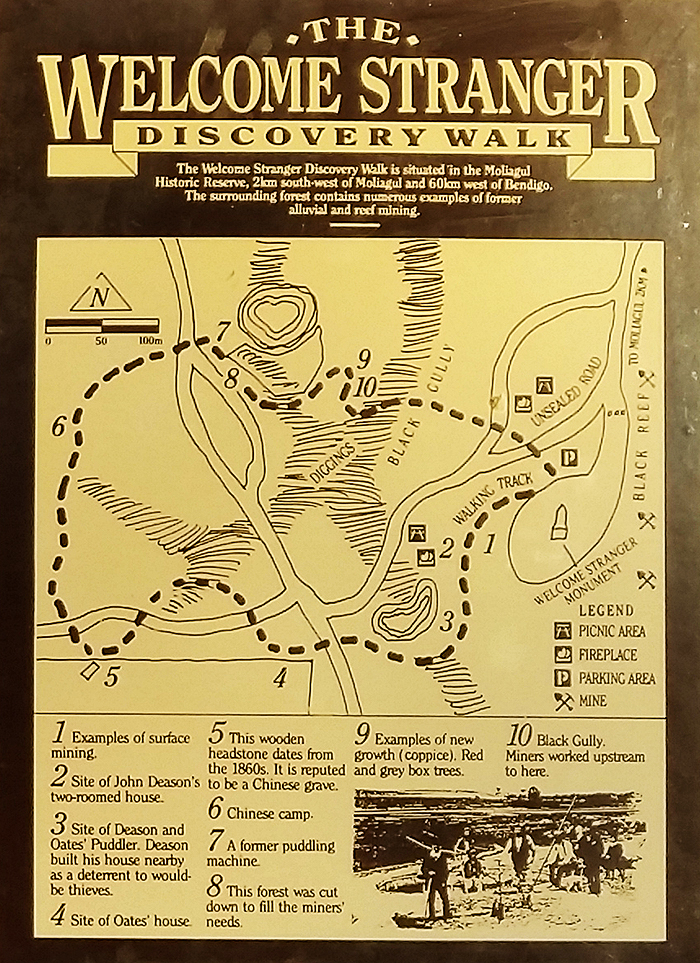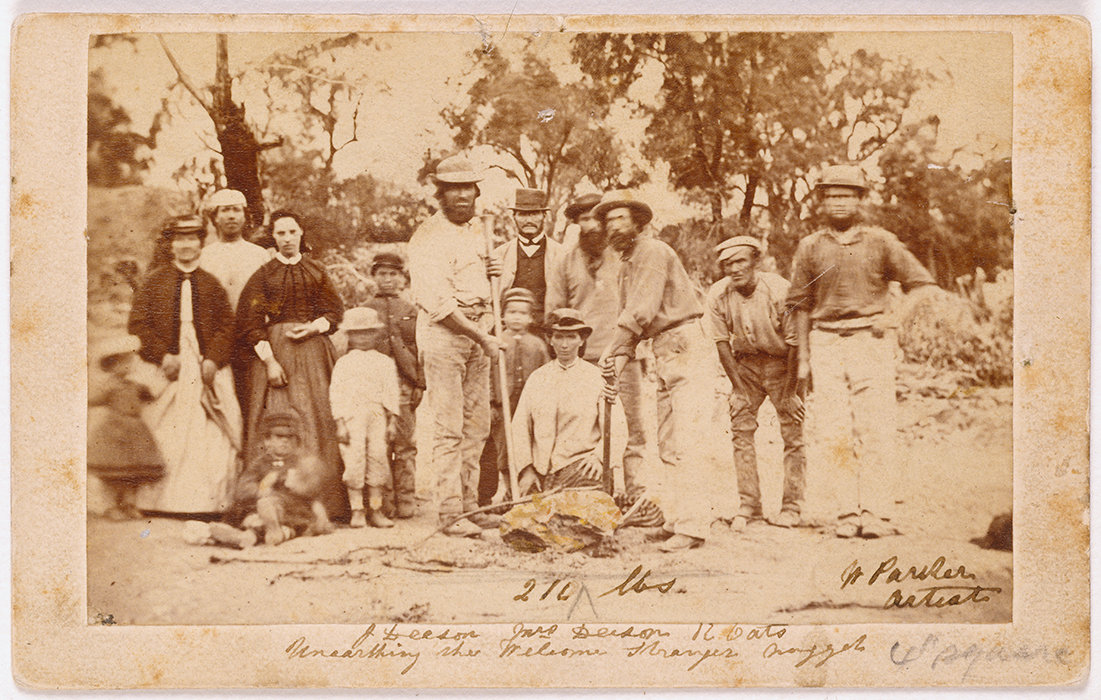Picnics and camping at the Welcome Stranger discovery site

The main picnic area is well equipped and includes picnic tables, wood fire barbecues, running water (not drinkable) and an undercover area.
Camping is available, there are a few nice spots to pitch tents and good caravan access. Keep in mind that there are no toilets at this site, but there is a toilet block a short drive away at the
Moliagul Campground.
WELCOME STRANGER GOLD NUGGET DISCOVERY MONUMENT
A large stone obelisk with a fence around it commemorates the discovery of the
Welcome Stranger gold nugget, and there's a beautifully presented information sign with plenty of interesting details about the discovery and the lives of the lucky miners who found it.
Gold prospecting near the Welcome Stranger discovery site
Gold prospecting is allowed within the Moliagul Historic Area.
Parks Victoria advises that "fossicking, prospecting and digging are permitted in the
Moliagul Historic Area, but all the artefacts in the Welcome
Stranger precinct and discovery walk are protected under the
Heritage Act 2017 and must not be disturbed. Penalties apply."
World-famous for the 1869 discovery of the Welcome Stranger gold nugget, the areas around Dunolly and Moliagul are a renowned destination for gold prospecting.
Filled with old diggings, historic sites and extensive areas of bushland, the region continues to produce regular gold nugget discoveries to this day.
If you're looking to try your luck gold prospecting around Dunolly and Moliagul, we've put together
this handy guide to get you started.
Welcome Stranger Discovery Walk
The
Welcome Stranger Discovery Walk is 850 metres long, a half hour circuit track.
The walking track travels around the surrounding bushland and takes you past many interesting examples of former alluvial and reef mining efforts.
You will walk by the house sites of John Deason and Richard Oates (the two miners who discovered the
Welcome Stranger nugget),
puddlers, a Chinese grave and the site of a Chinese camp.
There is a second picnic area partway along the walking track which features a picnic table and a wood fire barbecue.
The walk has direction markers to help you stay on track, and it used to have many 'point of interest' signs along the way but unfortunately most of them are now damaged.
Luckily there is a map on the information sign at the picnic area which indicates the points of interest along the way and what to look out for.
More information and history
The following information is displayed on an information sign at the Welcome Stranger Monument Picnic Area:
GOLD AT MOLIAGUL
The first recorded discovery of gold in this district was made about a kilometre from here in September 1852. This discovery created a rush in the area, and a Police Camp was established to keep law and order among the 4,000 miners.
Gold gradually became more difficult to find, and many miners left for more popular goldfields, though some with more substantial claims remained. Among these were two Cornish miners, John Deason and Richard Oates.
Both Deason and Oates were born on the island of Tresco, 50km south-west of Lands End, England. The two grew up together, and after learning of the discovery of gold in Australia, arrived in Bendigo in February 1854. They spent eight years there with only moderate success, and then moved to Moliagul.
Deason and Oates pegged a puddling claim on the side of this hill; they were aware of large nuggets having been found in the gully below (known as Black Gully).
They also selected farming land near this site which they continued to farm while stripping the surface layer of the puddling claim and washing it in a
puddling machine.
In 1866 the pair found a 1.1 kg (36 oz) nugget, which encouraged them to continue with their efforts. As history shows, their persistence paid off with the discovery of the "
Welcome Stranger", still the largest nugget ever found in the world.
THE DISCOVERY OF THE WELCOME STRANGER
On the morning of Friday 5 February 1869, Deason was breaking up soil on the claim when he hit what seemed to be stone. After hitting it a second and third time and clearing away the soil with a pick, he saw gold. The nugget was only 2.5cm (1 inch) below the surface; after clearing away more dirt Deason broke his pick handle in an attempt to lever it from the ground. He finally resorted to a crowbar.
Oates, busy ploughing in his nearby paddock, was called up by Deason's son. Not wanting to create suspicion among people living and working nearby, the two miners covered the nugget again and continued as if nothing had happened.
Later that afternoon the nugget was placed in their dray and taken down the hill to the Deason house. The gold was stained black by ironstone deposits and was mixed with a large quantity of quartz. After placing the nugget in the fire, the gold expanded and the quartz became brittle and loose. When the nugget cooled 26 kg of quartz was prised off and later crushed at a local battery, belonging to a Mr Edward Endey.
REVEALING THE FIND
After keeping the discovery to themselves all weekend, Deason and Oates decided to hold a party for their friends on the following Monday. They hid the nugget under a cloth at the end of the table, and at an appropriate moment during the evening revealed their magnificent prize. "Don't go home boys" said Deason, "That's solid gold and I want you to stay the night and escort it to the bank at Dunolly tomorrow".
Next morning, the nugget was loaded onto Edward Endey's spring cart and the convoy left for Dunolly. Walter Brown, a neighbour, was selected to go into the London Chartered Bank and ask the teller "What are you paying for gold by the hundred-weight?", after which the nugget was brought in and presented to the manager.
WEIGHING & RECORDING THE NUGGET
As the nugget was too large to be weighed on the bank scales, Archie Walls, the blacksmith was called in to cut it into smaller pieces. The total weight of the nugget, including what was obtained from the crushed quartz and other pieces broken off and given away to friends, was estimated at 72.5 kg (2,332 oz). It was considered a shame that in all the excitement no-one thought to photograph the nugget, and the only sketches made were drawn from memory. The photograph shown here was taken at the site later, the finders using a large piece of quartz to represent the nugget.
LIFE AFTER THE FIND
Soon after the find, Richard Oates returned to Cornwall, where he married Jane Penrose. He wasted little time in bringing her back to Moliagul and continued working the claim with Deason. By 1875 it had been worked out and Oates moved with his family to Dunolly. He continued farming, shifting a second time to land in Bealiba then later to Woodstock near bendigo. Richard Oates died in 1906 aged 79, and is buried in the Marong Cemetery.
John Deason continued with mining, having various puddling machines and later a quartz crushing battery. During the depression of the 1890's, part of his livelihood came from operating the battery in Moliagul, thus providing great stimulus and encouragement for other miners to sample reefs in the area instead of merely seeking alluvial gold. He invested money in further property, known as The Springs, at Moliagul, and he and his family moved there. His descendants still farm land in Moliagul today. John Deason died in 1915 aged 85 and is buried in the Moliagul Cemetery.
-----
- Welcome Stranger Anvil Monument in Dunolly. When the Welcome Stranger nugget was discovered in 1869, it was too large to fit on the bank scales to be weighed so was broken in half on an anvil. This anvil is now mounted on an attractive monument outside the Dunolly Museum.
- Moliagul Cemetery. The final resting place of John Deason, co-finder of the Welcome Stranger gold nugget.
PROSPECTORS AND MINERS ASSOCIATION VICTORIA
Established in 1980, the Prospectors and Miners Association of Victoria is a voluntary body created to protect the rights and opportunities of those who wish to prospect, fossick or mine in the State of Victoria, Australia.
You can support the PMAV in their fight to uphold these rights by
becoming a member. You'll also gain access to exclusive publications, field days, prospecting tips, discounts and competitions.




